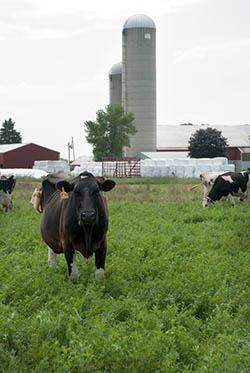 Happy cows come from California or Wisconsin or wherever. Whatever your opinion is as to where the happiest cows live, no doubt you have been asked about that popular saying. Research has shown animal welfare is at the forefront of consumers' minds. Belgian consumers ranked animal welfare as the number two priority in making food purchasing decisions while dairy producers and industry members in Canada rated it as the top management issue. One of the most common questions I field from urban consumers is how do you know your cows are happy?
Happy cows come from California or Wisconsin or wherever. Whatever your opinion is as to where the happiest cows live, no doubt you have been asked about that popular saying. Research has shown animal welfare is at the forefront of consumers' minds. Belgian consumers ranked animal welfare as the number two priority in making food purchasing decisions while dairy producers and industry members in Canada rated it as the top management issue. One of the most common questions I field from urban consumers is how do you know your cows are happy?Good question. For many years, dairy producers have pointed to high production and low incidents of sickness, which do indicate good animal welfare, but happiness of animals is an impossible thing to measure, as our animals cannot verbally communicate with us.
As early as the 1960s, researchers were working to quantify happy cows, and in the United Kingdom, they came up with the Five Freedoms of Animal Welfare.
- Freedom from hunger and thirst
- Freedom from discomfort
- Freedom from pain, injury or disease
- Freedom to express normal behavior
- Freedom from fear and distress
Researchers in Germany recently showed that some of these welfare indicators were positively correlated with technically efficient German dairies including a lower age at first calving and better milk production. They also found that animal welfare concerns such as high percentage of cow losses, a higher replacement rate and a longer calving interval had negative effects on the farms' technical efficiencies. These results back up many producers' claims that taking care of the cows is the core of an efficient and profitable operation. However, the researchers were also quick to point out that efficiency does not always mean good animal care since a higher somatic cell count was positively correlated with technical efficiency.
All that being said, it is important for producers to acknowledge the difference in consumers' definition of animal welfare from the very technically based definition outlined above. Many consumers define welfare as a state of pleasure and naturalness experienced by cows. The challenge that falls to the dairy industry is to continue to work to quantify animal welfare successes but also bridge the gap to explain how the objective measures of welfare available to us line up with their ideals for animal care.

The author is the Special Publications editor. She is responsible for development and marketing of books and plans, as well as coordinating internal communication pieces. Maggie was raised on a 150-cow dairy near Valley Center, Kan. and graduated from Kansas State University with degrees in agricultural communications and animal sciences.







